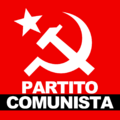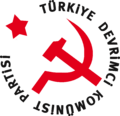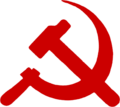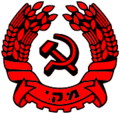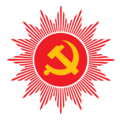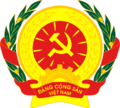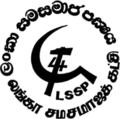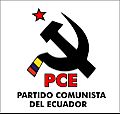Hammer and sickle facts for kids
The hammer and sickle are symbols often linked to communism. The hammer stands for workers in factories and industries. The sickle represents farmers and people who work in agriculture.
These symbols became very important in countries that followed communist ideas. However, some countries have made it illegal to use these symbols. This usually happens when the communist political party is banned. Countries like Hungary, Latvia, and Poland are examples of this.
Contents
What Do the Hammer and Sickle Mean?
The hammer and sickle together show the unity of workers and farmers. These two groups were seen as the main forces in building a communist society. The symbols represent their hard work and their importance in the economy.
History of the Symbols
The hammer and sickle became widely known after the Russian Revolution in 1917. They were used as the main symbol on the flag of the Soviet Union. This was a very large country that existed from 1922 to 1991. Many other communist parties and countries around the world also adopted these symbols.
Where You Might See Them
Even today, you might see the hammer and sickle in different places. They are still used by some political parties. You can also find them on old buildings, monuments, and flags from countries that were once communist. Sometimes, they appear in art or historical displays.
Why Some Countries Banned These Symbols
After the fall of the Soviet Union, many countries in Eastern Europe became independent. They had been under communist rule for a long time. For these countries, the hammer and sickle symbols are linked to a period of oppression and loss of freedom. Because of this, they decided to ban the symbols. This was a way to move away from their past and protect their new democratic governments.
Gallery
-
This is the logo of the Fourth International from 1938. This group is made up of organizations that follow Trotskyist ideas. It was formed because many groups with Stalinist ideas were part of another organization called Comintern.
Images for kids
-
The Chilean peso coin used the hammer and sickle symbol between 1894 and 1940.
-
The metro station, Plošča Lienina, in Minsk.
-
A statue showing a worker, a peasant, and an intellectual in front of the Juche Tower in Pyongyang.
-
The flag of the Communist Party of the Russian Federation.
-
An alternative emblem of the Communist Party of Vietnam.
-
The logo of the Communist Party of India.
See also
 In Spanish: Hoz y martillo para niños
In Spanish: Hoz y martillo para niños



















